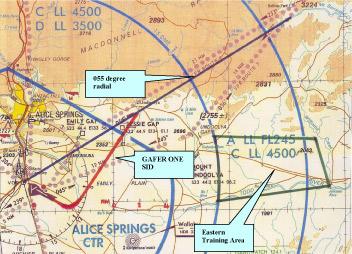On 17 November 2005, at 1327 Central Standard Time, a Boeing Company 717-200 (717) aircraft, registered VH-NXE, was inbound to Alice Springs, NT, on the 055 degree radial of the very high frequency omni-directional radio range (VOR) ground-based navigation aid, on a scheduled flight from Cairns, Qld. The 717 crew reported to the Alice Springs aerodrome controller that they passed almost overhead and within about 1,500 ft of a Cessna Aircraft Company C310R (C310) that was outbound from Alice Springs.
The C310, registered VH-JOI, was being operated on a pilot instrument rating renewal flight and, after becoming airborne off runway 12, was being tracked via a GAFER ONE standard instrument departure (SID), on climb to operate in a training area located to the east of Alice Springs (Figure 1), not above 6,000 ft. A SID is a published instrument flight rules departure comprising obstacle clearance data to the minimum safe altitude and tracking data until the aircraft reaches a specified point on its air traffic control cleared route. The GAFER ONE SID provided altitude requirements and heading instructions that enabled the pilot to intercept the 055 degree radial from the VOR.
Figure 1: Alice Springs visual terminal chart showing the 055 degree radial, the approximate track of the GAFER ONE standard instrument departure and the Eastern Training Area
The approved testing officer, who was also the pilot in command on board the C310, later reported that when the aircraft was at about 15 NM from Alice Springs, the pilot being tested turned the aircraft right, off the 055 degree radial of the VOR, and tracked towards the training area.
The Alice Springs airspace was not serviced by radar and as such the Alice Springs aerodrome controller was required to apply non-radar (procedural) control, in accordance with published procedures. The aerodrome controller was responsible for controlling aircraft operating within the Alice Springs control zone and control area up to 8,500 ft. Procedural control is achieved by the use of information from sources other than radar. The aerodrome controller intended to establish a lateral separation standard between the C310 and the inbound 717 once the C310 was established in the training area.
The aerodrome controller initially applied a vertical separation standard of 1,000 ft between the C310 and the 717. At 1326, the pilot of the C310 reported, to the aerodrome controller, that the C310 was established in the training area to the east of Alice Springs. That training area was procedurally separated, using a lateral separation standard, from the 055 degree radial from the Alice Springs VOR. Once the pilot of the C310 reported established in that training area, the C310 was laterally separated from the 717. The aerodrome controller then cleared the crew of the 717 to descend below the altitude of the C310.
About a minute later, the crew of the 717 reported that they had the C310 in sight about 1,500 ft below their aircraft. The pilot in command of the C310 later reported that he heard that broadcast made by the crew of the 717, but despite conducting a search for the 717, did not see the aircraft.



